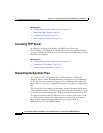
2-7
Cisco IP Phone Administration Guide for Cisco CallManager 3.3, Cisco IP Phones 7902G/7905G/7912G
OL-6313-01
Chapter 2 Preparing to Install the Cisco IP Phone on Your Network
Understanding the Phone Startup Process
After the phone obtains one of the .cnf.xml files or the .cnf file, the
Cisco IP Phone 7902G requests the profile file ffxxxxxxxxxxxx, the
Cisco IP Phone 7905G requests the profile file ldxxxxxxxxxxxx, and the
Cisco IP Phone 7912G requests the profile file gkxxxxxxxxxxxx, where each xx is
the two-digit lowercase hexadecimal representation of each integer in the phone’s
MAC address. If a phone cannot find this profile file, it requests the profile file
ffdefault.cfg for the Cisco IP Phone 7902G, the profile file lddefault.cfg for the
Cisco IP Phone 7905G, or the profile file gkdefault.cfg for the Cisco IP Phone
7912G. For more information about profile files, see Appendix A, “Additional
Configuration Methods, Parameters, and Procedures.”
After the phone finds one of the profile files, or if it cannot find a profile file, it
continues with its startup process.
Related Topics
• Understanding the Phone Startup Process, page 2-4
• Resolving Startup Problems, page 6-12
Contacting Cisco CallManager
The configuration file defines how the Cisco IP Phone communicates with
Cisco CallManager. After obtaining the file from the TFTP server, the phone
attempts to make a TCP connection to the highest priority Cisco CallManager on
the list.
If the phone was manually added to the database, Cisco CallManager identifies
the phone. If the phone was not manually added to the database and
auto-registration is enabled in Cisco CallManager, the phone attempts to
auto-register itself in the Cisco CallManager database.
Cisco CallManager informs devices using .cnf format configuration files of their
load ID. Devices using .xml format configuration files receive the load ID in the
configuration file.
Related Topics
• Understanding the Phone Startup Process, page 2-4
• Resolving Startup Problems, page 6-12


















